
|

|
The Astro-Physics 1200 GTO mount is an outstanding imaging platform and I'm fortunate to own and use one.The following information
was excerpted from the Astro-Physics website, nothing I can write offers a superior summary:
"With the advent of the CCD camera, amateurs are exploring the skies to an ever increasing level of precision, easily exceeding the image quality of large observatories using film techniques decades ago. This new level puts a higher demand on the precision of the equatorial mounting. Many of the finest imagers today have been using our GTO mounts as a solid platform for a wide variety of instruments. The largest of these is our 1200GTO. Since its introduction in 1998, the 1200GTO has gained a reputation for both tracking and pointing accuracy, essential to casual visual observation as well as advanced imaging." "These mounts are truly a marvel of engineering - maximum strength and rigidity with minimum weight. Our CNC lathes and mills carve out the excess material in both axes of the 1200 and 900 German Equatorials while retaining a heavily ribbed structure for internal strength and rigidity. A unique dovetail was machined into the mating surfaces of the R.A. and Dec axes. This feature allows quick and easy assembly in the field without any tools." Schematic courtesy of Astro-Physics 1200 GTO Manual | ||
|
Arrival 2003 Here's a photo of my 1200 GTO mount newly arrived and set up at my friend George's house. I have learned that a good German Equatorial Mount (GEM) is the single most important part of an imaging system. I would also comment that in my view no mount is too heavy if your goal is astrophotography. Using the 1200 has proven to be a step forward in my efforts. Once you obtain a good mount the optical tube possibilities and what one may use for accessories increases considerably. I purchased an A-P pier and used it successfully when I first received the mount. You'll notice later that I purchased a Monolith pier which is a phenomenal unit, rock solid and without flexure with the payloads I use. I later sold the A-P version and use the Monolith for a portable system. The Astro-Physics 1200 GTO is a beautiful and versatile precision device. For a visual system it may not offer the portability of A-P's lighter designs, but my focus is imaging and for this task it excels. It is portable but fairly heavy; the equatorial head combined weighs 81 pounds. It breaks down into two sections, the Declination axis at 31 and the Right Ascension axis at 50 pounds. The standard counterweight shaft weighs 10 pounds, although I sometimes use the longer version that weighs more. I had a pair of ScopeGuard custom cases constructed for my 1200 which included storage space for the electronics and accessories. Some of the newer upgrades offered have been added on my mount and eventually all will be incorporated. A-P continually researches and improves their products; all of these modifications are worth pursuing. |
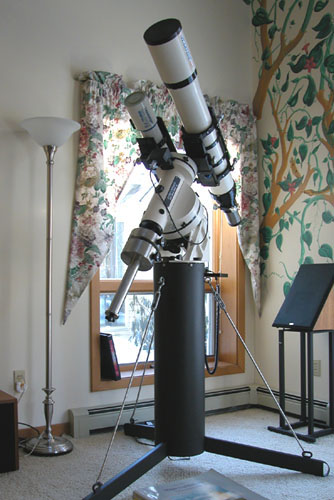
|
||

|
Here's a view of my imaging set up in the field taken at the Summer Star Party in Savoy, Massachusetts in 2003. This shot depicts several operational
features of the mount. The clutch knobs can be viewed next to the setting circle readout bands on both the Dec and R.A. sections. Each axis has four
clutch knobs that can be adjusted to loosen or restrict movement. Once aligned and in goto mode these remain tightened down. The altitude locking knob can be
viewed just below the R.A. section. This allows adjustment for site latitude and provides a range of 21.5 to 68 degrees in four seperate mount positions. You can see the dovetail plate located above the 130mm scope that serves as a camera platform. Also in view are the rings that support the Telrad base (a non-optical pointing device), which are mounted independently. These rings solved one of the problems I had of continuously re-calibrating the Telrad with changes to the system. This works well because no matter what configuration I choose the Telrad position remains fairly constant and the base can be relocated on the scope as required. | ||
| This interior shot depicts a Pentax 6X7 medium format camera set up with a 300mm lens for widefield at top and exhibits the payload versatility of the 1200 mount. This camera and lens were added in preparation for our trip to New Mexico Skies in May 2003. The lens is supported by a Losmandy Astronomical Products 125mm guide tube ring. The middle body has a 165mm and the bottom a 90mm lens and displays the widefield potential of the system. I received the Tak FSQ before the New Mexico trip and took the FS78, shown with a 35mm Nikon body, out of the system. With the four Pentax bodies I stopped shooting with 35mm except for camera on tripod type images. The eFinder, used for autoguiding, can be viewed mounted below the camera platform on a plate in this photograph; look between the bottom two lenses and you'll see the capped snout projecting through. |
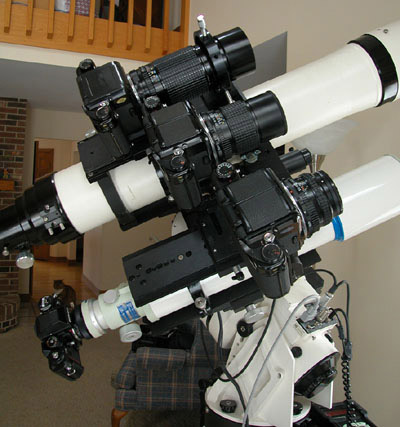
|
||
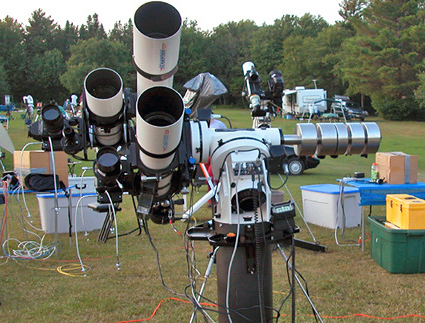
|
This photograph shows three telescopes mounted with a five camera system at SSP '03. The 1200 mount can carry a load like this easily and balancing isn't really an issue
provided you have enough counterweights available. Both of my Astro-Physics 130mm refractors are mounted side-by-side in this photo, the Takahashi FSQ-106N
is on top of the 130mm f8.35. Two Pentax 6X7 lens cameras can be viewed mounted as well. Each of these telescopes can accept a 6X7 body or a CCD camera.
It was around this time I started into CCD imaging. This image provides a look at the R.A. axis housing. This covers a 225 toothed aluminum wheel 10.3 inches in diameter. The Dec axis has a 225 toothed aluminum wheel that is 7.2 inches. The tracking accuracy of the 1200 is exceptional and with the newer software available these days many imagers are doing unguided exposures approaching five minutes or more. This isn't something I'm interested in but it speaks well of the quality of the product. Astro-Physics states, 'These mounts are truly a marvel of engineering...' I'd have to agree... | ||
|
This is a photo of the imaging system I used at Chiefland Astronomy Village on our latest imaging excursion in January 2005. I used faster refractors during this session,
the Astro-Physics 130mm f6 and Takahashi FSQ-106N at f5 due to the better sky conditions Florida experiences, at least better than Maine when clear. You can see the STL-11000M
CCD mounted on the FSQ and two 6X7 lens cameras piggybacked. In this set up the 130mm EDFS is being used a guidescope and has the STV head installed. The green and blue tubing is for the desiccated air purge and water cooling to reduce
the chip temperature. We didn't have a good span of clear weather but were able to shoot three or four nights out of ten.
This image displays the versatility of the 1200 mount - modifying the equipment configuration isn't difficult and this set up isn't approaching
the stated payload capacity of 140 pounds for telescopes and accessories. Here it is installed on my 42 inch Monolith pier using A-P support bars and accessory trays on two sides. Critical polar alignment is essential for good images and a task I've become proficient with. The system in Florida was checked daily to make certain ground settlement wasn't an issue. The Astro-Physics polar scope is accurate and works well to align the mount. We've found this is all that's required for CCD images of around fifteen minutes. I haven't done a drift alignment protocol for quite some time now and don't really miss the time formerly dedicated to this effort. The latitude in Florida is 14 degrees below my home location so the mount had to be adjusted down one altitude setting and fine tuned using the polar scope. The 1200 azimuth adjustment is approximately 14 degrees (7 degrees each way from center) and with the full index adapter on the Monolith, allowing you to swivel the mount even when loaded, getting close initially is fairly quick. Getting to know the capabilities of your mount (as well as all your equipment) provides a comfort level in deciding how much time to expend with alignment issues. One great advantage off CCD is you can check for star drift immediately unlike the days of film when the discovery came after processing - far too late to correct the problem. The 1200 GTO has proven to be an outstanding CCD imaging platform... |
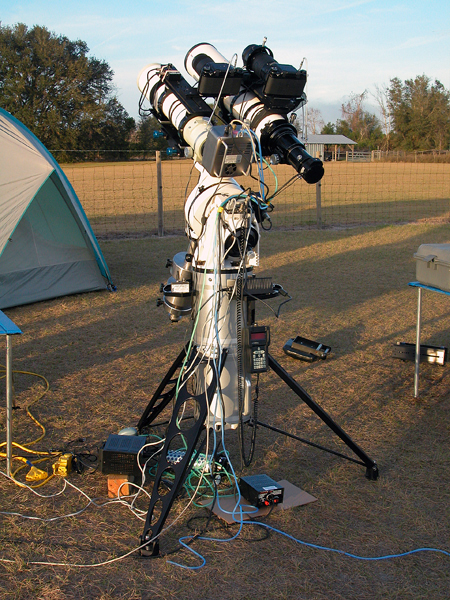
|
||
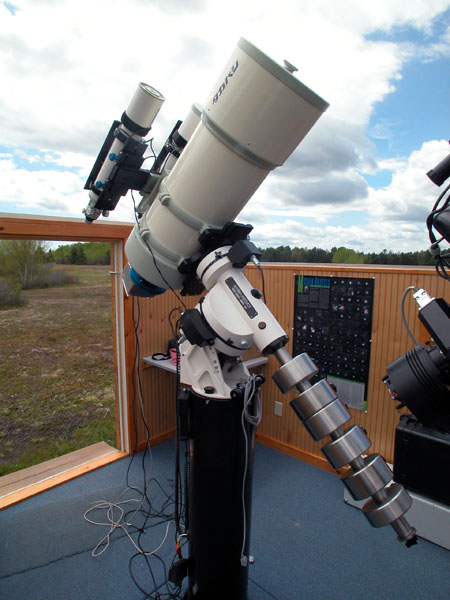
|
The final view of this group shows the 1200 mount installed on a permanent pier at Starburst Meadows Observatory where it was moved in April 2005.
This photo depicts a Takahashi FRC-300, which is a modified Ritchie-Chretien. You can see Rob's C-14 in the forefront of this shot.
The observatory has two piers and Rob's scope is on a 900 GTO, the 1200's smaller version and an excellent mount. Purchase of the A-P optional,
longer counterweight shaft was required to get enough weights on to balance the FRC, Takahashi FSQ and FS78 guidescope
mounted in this photo. This image provides a good view of the altitude and azimuth adjustment knobs located at the front of the mount
just above the pier cap. Obtaining an Astro-Physics mount can be considered a lengthy process in today's world of 'instant gratification', but is well worth the wait overall. There are multiple options for good quality mounts available these days and it is clearly a good time to be in astronomy in this regard. However, many imagers using A-P mounts received them off 'the list' - put their names in and waited for production to finally catch up until they're contacted. Once you have and use one, the wait will appear insignificant. Please visit the Astro-Physics website for more details related to this and their other fine mounts and products.
| ||
or go
Home
